See discussions, stats, and author profiles for this publication at: https://www.researchgate.net/publication/2985446
Gradient-Based Learning Applied to Document Recognition
READS
12,451
Y. Bengio
Université de Montréal
680 PUBLICATIONS 91,012 CITATIONS
SEE PROFILE
Article in Proceedings of the IEEE · December 1998
DOI: 10.1109/5.726791 · Source: IEEE Xplore
CITATIONS
10,313
4 authors, including:
Yann Lecun
New York University
522 PUBLICATIONS 49,788 CITATIONS
SEE PROFILE
Patrick Haffner
Interactions LLC
81 PUBLICATIONS 14,069 CITATIONS
SEE PROFILE
Some of the authors of this publication are also working on these related projects:
MoDeep View project
Parsing View project
All content following this page was uploaded by Yann Lecun on 23 May 2013.
The user has requested enhancement of the downloaded file.
�
YannLeCun,LeonBottou,YoshuaBengio,andPatrickHaner
I.Introduction
PROC.OFTHEIEEE,NOVEMBER� �
�
Gradient-BasedLearningAppliedtoDocument
Recognition
Abstract|
MultilayerNeuralNetworkstrainedwiththebackpropa-
gationalgorithmconstitutethebestexampleofasuccessful
Overthelastseveralyears,machinelearningtechniques,
Gradient-BasedLearningtechnique.Givenanappropriate
particularlywhenappliedtoneuralnetworks,haveplayed
networkarchitecture,Gradient-BasedLearningalgorithms
anincreasinglyimportantroleinthedesignofpattern
canbeusedtosynthesizeacomplexdecisionsurfacethatcan
recognitionsystems.Infact,itcouldbearguedthatthe
classifyhigh-dimensionalpatternssuchashandwrittenchar-
acters,withminimalpreprocessing.Thispaperreviewsvar-
availabilityoflearningtechniqueshasbeenacrucialfac-
iousmethodsappliedtohandwrittencharacterrecognition
torintherecentsuccessofpatternrecognitionapplica-
andcomparesthemonastandardhandwrittendigitrecog-
tionssuchascontinuousspeechrecognitionandhandwrit-
nitiontask.ConvolutionalNeuralNetworks,thatarespecif-
icallydesignedtodealwiththevariabilityof�Dshapes,are
ingrecognition.
showntooutperformallothertechniques.
Themainmessageofthispaperisthatbetterpattern
Real-lifedocumentrecognitionsystemsarecomposed
recognitionsystemscanbebuiltbyrelyingmoreonauto-
ofmultiplemodulesincludingeldextraction,segmenta-
tion,recognition,andlanguagemodeling.Anewlearning
maticlearning,andlessonhand-designedheuristics.This
paradigm,calledGraphTransformerNetworks(GTN),al-
ismadepossiblebyrecentprogressinmachinelearning
lowssuchmulti-modulesystemstobetrainedgloballyusing
andcomputertechnology.Usingcharacterrecognitionas
Gradient-Basedmethodssoastominimizeanoverallper-
acasestudy,weshowthathand-craftedfeatureextrac-
formancemeasure.
Twosystemsforon-linehandwritingrecognitionarede-
tioncanbeadvantageouslyreplacedbycarefullydesigned
scribed.Experimentsdemonstratetheadvantageofglobal
learningmachinesthatoperatedirectlyonpixelimages.
training,andtheexibilityofGraphTransformerNetworks.
Usingdocumentunderstandingasacasestudy,weshow
AGraphTransformerNetworkforreadingbankcheckis
thatthetraditionalwayofbuildingrecognitionsystemsby
alsodescribed.ItusesConvolutionalNeuralNetworkchar-
acterrecognizerscombinedwithglobaltrainingtechniques
manuallyintegratingindividuallydesignedmodulescanbe
toprovidesrecordaccuracyonbusinessandpersonalchecks.
replacedbyauniedandwell-principleddesignparadigm,
Itisdeployedcommerciallyandreadsseveralmillionchecks
calledGraphTransformerNetworks,thatallowstraining
perday.
allthemodulestooptimizeaglobalperformancecriterion.
Keywords|NeuralNetworks,OCR,DocumentRecogni-
tion,MachineLearning,Gradient-BasedLearning,Convo-
Sincetheearlydaysofpatternrecognitionithasbeen
lutionalNeuralNetworks,GraphTransformerNetworks,Fi-
knownthatthevariabilityandrichnessofnaturaldata,
niteStateTransducers.Nomenclature
beitspeech,glyphs,orothertypesofpatterns,makeit
almostimpossibletobuildanaccuraterecognitionsystem
entirelybyhand.Consequently,mostpatternrecognition
systemsarebuiltusingacombinationofautomaticlearn-
GTGraphtransformer.
ingtechniquesandhand-craftedalgorithms.Theusual
GTNGraphtransformernetwork.
methodofrecognizingindividualpatternsconsistsindivid-
HMMHiddenMarkovmodel.
ingthesystemintotwomainmodulesshowningure�.
HOSHeuristicoversegmentation.
Therstmodule,calledthefeatureextractor,transforms
K-NNK-nearestneighbor.
theinputpatternssothattheycanberepresentedbylow-
NNNeuralnetwork.
dimensionalvectorsorshortstringsofsymbolsthat(a)can
OCROpticalcharacterrecognition.
beeasilymatchedorcompared,and(b)arerelativelyin-
PCAPrincipalcomponentanalysis.
variantwithrespecttotransformationsanddistortionsof
RBFRadialbasisfunction.
theinputpatternsthatdonotchangetheirnature.The
RS-SVMReduced-setsupportvectormethod.
featureextractorcontainsmostofthepriorknowledgeand
SDNNSpacedisplacementneuralnetwork.
isratherspecictothetask.Itisalsothefocusofmostof
SVMSupportvectormethod.
thedesigneort,becauseitisoftenentirelyhand-crafted.
TDNNTimedelayneuralnetwork.
Theclassier,ontheotherhand,isoftengeneral-purpose
V-SVMVirtualsupportvectormethod.
andtrainable.Oneofthemainproblemswiththisap-
proachisthattherecognitionaccuracyislargelydeter-
ImagePro-
arewith
Speech
the
The
authors
and
minedbytheabilityofthedesignertocomeupwithan
cessing
Services
Research
Laboratory,
AT&T
Labs-
appropriatesetoffeatures.Thisturnsouttobeadaunt-
Research,���SchulzDriveRedBank,NJ�����.
E-mail:
fyann,leonb,yoshua,hanerg@research.att.com.
YoshuaBengio
ingtaskwhich,unfortunately,mustberedoneforeachnew
isalsowiththeDepartementd'InformatiqueetdeRecherche
problem.Alargeamountofthepatternrecognitionliter-
Operationelle,UniversitedeMontreal,C.P.����Succ.Centre-Ville,
� ��ChemindelaTour,Montreal,Quebec,CanadaH�C�J�.
atureisdevotedtodescribingandcomparingtherelative
�
Class scores
Feature vector
Raw input
FEATURE EXTRACTION MODULE
TRAINABLE CLASSIFIER MODULE
PROC.OFTHEIEEE,NOVEMBER� �
Fig.�.Traditionalpatternrecognitionisperformedwithtwomod-
ules:axedfeatureextractor,andatrainableclassier.
meritsofdierentfeaturesetsforparticulartasks.
Historically,theneedforappropriatefeatureextractors
wasduetothefactthatthelearningtechniquesusedby
theclassierswerelimitedtolow-dimensionalspaceswith
easilyseparableclasses[�].Acombinationofthreefactors
havechangedthisvisionoverthelastdecade.First,the
availabilityoflow-costmachineswithfastarithmeticunits
allowstorelymoreonbrute-force\numerical"methods
thanonalgorithmicrenements.Second,theavailability
oflargedatabasesforproblemswithalargemarketand
wideinterest,suchashandwritingrecognition,hasenabled
designerstorelymoreonrealdataandlessonhand-crafted
featureextractiontobuildrecognitionsystems.Thethird
andveryimportantfactoristheavailabilityofpowerfulma-
chinelearningtechniquesthatcanhandlehigh-dimensional
inputsandcangenerateintricatedecisionfunctionswhen
fedwiththeselargedatasets.Itcanbearguedthatthe
recentprogressintheaccuracyofspeechandhandwriting
recognitionsystemscanbeattributedinlargeparttoan
increasedrelianceonlearningtechniquesandlargetraining
datasets.Asevidencetothisfact,alargeproportionof
moderncommercialOCRsystemsusesomeformofmulti-
layerNeuralNetworktrainedwithback-propagation.
Inthisstudy,weconsiderthetasksofhandwrittenchar-
acterrecognition(SectionsIandII)andcomparetheper-
formanceofseverallearningtechniquesonabenchmark
datasetforhandwrittendigitrecognition(SectionIII).
Whilemoreautomaticlearningisbenecial,nolearning
techniquecansucceedwithoutaminimalamountofprior
knowledgeaboutthetask.Inthecaseofmulti-layerneu-
ralnetworks,agoodwaytoincorporateknowledgeisto
tailoritsarchitecturetothetask.ConvolutionalNeu-
ralNetworks[�]introducedinSectionIIareanexam-
pleofspecializedneuralnetworkarchitectureswhichin-
corporateknowledgeabouttheinvariancesof�Dshapes
byusinglocalconnectionpatterns,andbyimposingcon-
straintsontheweights.Acomparisonofseveralmethods
forisolatedhandwrittendigitrecognitionispresentedin
sectionIII.Togofromtherecognitionofindividualchar-
acterstotherecognitionofwordsandsentencesindocu-
ments,theideaofcombiningmultiplemodulestrainedto
reducetheoverallerrorisintroducedinSectionIV.Rec-
ognizingvariable-lengthobjectssuchashandwrittenwords
usingmulti-modulesystemsisbestdoneifthemodules
�
manipulatedirectedgraphs.Thisleadstotheconceptof
trainableGraphTransformerNetwork(GTN)alsointro-
ducedinSectionIV.SectionVdescribesthenowclas-
sicalmethodofheuristicover-segmentationforrecogniz-
ingwordsorothercharacterstrings.Discriminativeand
non-discriminativegradient-basedtechniquesfortraining
arecognizeratthewordlevelwithoutrequiringmanual
segmentationandlabelingarepresentedinSectionVI.Sec-
tionVIIpresentsthepromisingSpace-DisplacementNeu-
ralNetworkapproachthateliminatestheneedforseg-
mentationheuristicsbyscanningarecognizeratallpos-
siblelocationsontheinput.InsectionVIII,itisshown
thattrainableGraphTransformerNetworkscanbefor-
mulatedasmultiplegeneralizedtransductions,basedona
generalgraphcompositionalgorithm.Theconnectionsbe-
tweenGTNsandHiddenMarkovModels,commonlyused
inspeechrecognitionisalsotreated.SectionIXdescribes
agloballytrainedGTNsystemforrecognizinghandwrit-
ingenteredinapencomputer.Thisproblemisknownas
\on-line"handwritingrecognition,sincethemachinemust
produceimmediatefeedbackastheuserwrites.Thecoreof
thesystemisaConvolutionalNeuralNetwork.Theresults
clearlydemonstratetheadvantagesoftrainingarecognizer
atthewordlevel,ratherthantrainingitonpre-segmented,
hand-labeled,isolatedcharacters.SectionXdescribesa
completeGTN-basedsystemforreadinghandwrittenand
machine-printedbankchecks.Thecoreofthesystemisthe
ConvolutionalNeuralNetworkcalledLeNet-�describedin
SectionII.ThissystemisincommercialuseintheNCR
Corporationlineofcheckrecognitionsystemsforthebank-
ingindustry.Itisreadingmillionsofcheckspermonthin
severalbanksacrosstheUnitedStates.
A.LearningfromData
Thereareseveralapproachestoautomaticmachine
learning,butoneofthemostsuccessfulapproaches,pop-
ularizedinrecentyearsbytheneuralnetworkcommunity,
canbecalled\numerical"orgradient-basedlearning.The
learningmachinecomputesafunctionYp=F(Zp;W)
whereZpisthep-thinputpattern,andWrepresentsthe
collectionofadjustableparametersinthesystem.
Ina
patternrecognitionsetting,theoutputYpmaybeinter-
pretedastherecognizedclasslabelofpatternZp,oras
scoresorprobabilitiesassociatedwitheachclass.Aloss
functionEp=D(Dp;F(W;Zp)),measuresthediscrep-
ancybetweenDp,the\correct"ordesiredoutputforpat-
ternZp,andtheoutputproducedbythesystem.The
averagelossfunctionEtrain(W)istheaverageoftheer-
rorsEpoverasetoflabeledexamplescalledthetraining
setf(Z�;D�);::::(ZP;DP)g.
Inthesimplestsetting,the
learningproblemconsistsinndingthevalueofWthat
minimizesEtrain(W).Inpractice,theperformanceofthe
systemonatrainingsetisoflittleinterest.Themorerel-
evantmeasureistheerrorrateofthesystemintheeld,
whereitwouldbeusedinpractice.Thisperformanceis
estimatedbymeasuringtheaccuracyonasetofsamples
disjointfromthetrainingset,calledthetestset.Much
theoreticalandexperimentalwork[�],[�],[�]hasshown
�
PROC.OFTHEIEEE,NOVEMBER� �
thatthegapbetweentheexpectederrorrateonthetest
setEtestandtheerrorrateonthetrainingsetEtrainde-
creaseswiththenumberoftrainingsamplesapproximately
as
EtestEtrain=k(h=P)
(�)
wherePisthenumberoftrainingsamples,hisameasureof
\eectivecapacity"orcomplexityofthemachine[�],[�],
isanumberbetween�:�and�:�,andkisaconstant.This
gapalwaysdecreaseswhenthenumberoftrainingsamples
increases.Furthermore,asthecapacityhincreases,Etrain
decreases.Therefore,whenincreasingthecapacityh,there
isatrade-obetweenthedecreaseofEtrainandthein-
creaseofthegap,withanoptimalvalueofthecapacityh
thatachievesthelowestgeneralizationerrorEtest.Most
learningalgorithmsattempttominimizeEtrainaswellas
someestimateofthegap.Aformalversionofthisiscalled
structuralriskminimization[�],[�],andisbasedonden-
ingasequenceoflearningmachinesofincreasingcapacity,
correspondingtoasequenceofsubsetsoftheparameter
spacesuchthateachsubsetisasupersetoftheprevious
subset.Inpracticalterms,StructuralRiskMinimization
isimplementedbyminimizingEtrain+H(W),wherethe
functionH(W)iscalledaregularizationfunction,andis
aconstant.H(W)ischosensuchthatittakeslargeval-
uesonparametersWthatbelongtohigh-capacitysubsets
oftheparameterspace.MinimizingH(W)ineectlim-
itsthecapacityoftheaccessiblesubsetoftheparameter
space,therebycontrollingthetradeobetweenminimiz-
ingthetrainingerrorandminimizingtheexpectedgap
betweenthetrainingerrorandtesterror.
B.Gradient-BasedLearning
Thegeneralproblemofminimizingafunctionwithre-
specttoasetofparametersisattherootofmanyissuesin
computerscience.Gradient-BasedLearningdrawsonthe
factthatitisgenerallymucheasiertominimizeareason-
ablysmooth,continuousfunctionthanadiscrete(combi-
natorial)function.Thelossfunctioncanbeminimizedby
estimatingtheimpactofsmallvariationsoftheparame-
tervaluesonthelossfunction.Thisismeasuredbythe
gradientofthelossfunctionwithrespecttotheparam-
eters.Ecientlearningalgorithmscanbedevisedwhen
thegradientvectorcanbecomputedanalytically(asop-
posedtonumericallythroughperturbations).Thisisthe
basisofnumerousgradient-basedlearningalgorithmswith
continuous-valuedparameters.Intheproceduresdescribed
inthisarticle,thesetofparametersWisareal-valuedvec-
tor,withrespecttowhichE(W)iscontinuous,aswellas
dierentiablealmosteverywhere.Thesimplestminimiza-
tionprocedureinsuchasettingisthegradientdescent
algorithmwhereWisiterativelyadjustedasfollows:
Wk=Wk�@E(W)
(�)
@W:
Inthesimplestcase,isascalarconstant.Moresophisti-
catedproceduresusevariable,orsubstituteitforadiag-
onalmatrix,orsubstituteitforanestimateoftheinverse
�
HessianmatrixasinNewtonorQuasi-Newtonmethods.
TheConjugateGradientmethod[�]canalsobeused.
However,AppendixBshowsthatdespitemanyclaims
tothecontraryintheliterature,theusefulnessofthese
second-ordermethodstolargelearningmachinesisvery
limited.Apopularminimizationprocedureisthestochasticgra-
dientalgorithm,alsocalledtheon-lineupdate.Itconsists
inupdatingtheparametervectorusinganoisy,orapprox-
imated,versionoftheaveragegradient.Inthemostcom-
moninstanceofit,Wisupdatedonthebasisofasingle
sample:
Wk=Wk�@Epk(W)
(�)
@W
Withthisproceduretheparametervectoructuates
aroundanaveragetrajectory,butusuallyconvergesconsid-
erablyfasterthanregulargradientdescentandsecondor-
dermethodsonlargetrainingsetswithredundantsamples
(suchasthoseencounteredinspeechorcharacterrecogni-
tion).ThereasonsforthisareexplainedinAppendixB.
Thepropertiesofsuchalgorithmsappliedtolearninghave
beenstudiedtheoreticallysincethe� ��'s[ ],[��],[��],
butpracticalsuccessesfornon-trivialtasksdidnotoccur
untilthemideighties.
C.GradientBack-Propagation
Gradient-BasedLearningprocedureshavebeenused
sincethelate� ��'s,buttheyweremostlylimitedtolin-
earsystems[�].Thesurprisingusefulnessofsuchsim-
plegradientdescenttechniquesforcomplexmachinelearn-
ingtaskswasnotwidelyrealizeduntilthefollowingthree
eventsoccurred.Thersteventwastherealizationthat,
despiteearlywarningstothecontrary[��],thepresence
oflocalminimainthelossfunctiondoesnotseemto
beamajorprobleminpractice.Thisbecameapparent
whenitwasnoticedthatlocalminimadidnotseemto
beamajorimpedimenttothesuccessofearlynon-linear
gradient-basedLearningtechniquessuchasBoltzmannma-
chines[��],[��].Thesecondeventwasthepopularization
byRumelhart,HintonandWilliams[��]andothersofa
simpleandecientprocedure,theback-propagational-
gorithm,tocomputethegradientinanon-linearsystem
composedofseverallayersofprocessing.Thethirdevent
wasthedemonstrationthattheback-propagationproce-
dureappliedtomulti-layerneuralnetworkswithsigmoidal
unitscansolvecomplicatedlearningtasks.Thebasicidea
ofback-propagationisthatgradientscanbecomputede-
cientlybypropagationfromtheoutputtotheinput.This
ideawasdescribedinthecontroltheoryliteratureofthe
earlysixties[��],butitsapplicationtomachinelearning
wasnotgenerallyrealizedthen.
Interestingly,theearly
derivationsofback-propagationinthecontextofneural
networklearningdidnotusegradients,but\virtualtar-
gets"forunitsinintermediatelayers[��],[��],orminimal
disturbancearguments[� ].TheLagrangeformalismused
inthecontroltheoryliteratureprovidesperhapsthebest
rigorousmethodforderivingback-propagation[��],andfor
derivinggeneralizationsofback-propagationtorecurrent
�
PROC.OFTHEIEEE,NOVEMBER� �
networks[��],andnetworksofheterogeneousmodules[��].
Asimplederivationforgenericmulti-layersystemsisgiven
inSectionI-E.
Thefactthatlocalminimadonotseemtobeaproblem
formulti-layerneuralnetworksissomewhatofatheoretical
mystery.Itisconjecturedthatifthenetworkisoversized
forthetask(asisusuallythecaseinpractice),thepresence
of\extradimensions"inparameterspacereducestherisk
ofunattainableregions.Back-propagationisbyfarthe
mostwidelyusedneural-networklearningalgorithm,and
probablythemostwidelyusedlearningalgorithmofany
form.D.LearninginRealHandwritingRecognitionSystems
Isolatedhandwrittencharacterrecognitionhasbeenex-
tensivelystudiedintheliterature(see[��],[��]forreviews),
andwasoneoftheearlysuccessfulapplicationsofneural
networks[��].Comparativeexperimentsonrecognitionof
individualhandwrittendigitsarereportedinSectionIII.
TheyshowthatneuralnetworkstrainedwithGradient-
BasedLearningperformbetterthanallothermethods
testedhereonthesamedata.Thebestneuralnetworks,
calledConvolutionalNetworks,aredesignedtolearnto
extractrelevantfeaturesdirectlyfrompixelimages(see
SectionII).
Oneofthemostdicultproblemsinhandwritingrecog-
nition,however,isnotonlytorecognizeindividualcharac-
ters,butalsotoseparateoutcharactersfromtheirneigh-
borswithinthewordorsentence,aprocessknownasseg-
mentation.Thetechniquefordoingthisthathasbecome
the\standard"iscalledHeuristicOver-Segmentation.It
consistsingeneratingalargenumberofpotentialcuts
betweencharactersusingheuristicimageprocessingtech-
niques,andsubsequentlyselectingthebestcombinationof
cutsbasedonscoresgivenforeachcandidatecharacterby
therecognizer.Insuchamodel,theaccuracyofthesys-
temdependsuponthequalityofthecutsgeneratedbythe
heuristics,andontheabilityoftherecognizertodistin-
guishcorrectlysegmentedcharactersfrompiecesofchar-
acters,multiplecharacters,orotherwiseincorrectlyseg-
mentedcharacters.Trainingarecognizertoperformthis
taskposesamajorchallengebecauseofthedicultyincre-
atingalabeleddatabaseofincorrectlysegmentedcharac-
ters.Thesimplestsolutionconsistsinrunningtheimages
ofcharacterstringsthroughthesegmenter,andthenman-
uallylabelingallthecharacterhypotheses.Unfortunately,
notonlyisthisanextremelytediousandcostlytask,itis
alsodiculttodothelabelingconsistently.Forexample,
shouldtherighthalfofacutup�belabeledasa�oras
anon-character?shouldtherighthalfofacutup�be
labeledasa�?
Therstsolution,describedinSectionVconsistsin
trainingthesystematthelevelofwholestringsofchar-
acters,ratherthanatthecharacterlevel.Thenotionof
Gradient-BasedLearningcanbeusedforthispurpose.The
systemistrainedtominimizeanoveralllossfunctionwhich
measurestheprobabilityofanerroneousanswer.SectionV
exploresvariouswaystoensurethatthelossfunctionisdif-
�
ferentiable,andthereforelendsitselftotheuseofGradient-
BasedLearningmethods.SectionVintroducestheuseof
directedacyclicgraphswhosearcscarrynumericalinfor-
mationasawaytorepresentthealternativehypotheses,
andintroducestheideaofGTN.
ThesecondsolutiondescribedinSectionVIIistoelim-
inatesegmentationaltogether.Theideaistosweepthe
recognizerovereverypossiblelocationontheinputimage,
andtorelyonthe\characterspotting"propertyoftherec-
ognizer,i.e.itsabilitytocorrectlyrecognizeawell-centered
characterinitsinputeld,eveninthepresenceofother
charactersbesidesit,whilerejectingimagescontainingno
centeredcharacters[��],[��].Thesequenceofrecognizer
outputsobtainedbysweepingtherecognizeroverthein-
putisthenfedtoaGraphTransformerNetworkthattakes
linguisticconstraintsintoaccountandnallyextractsthe
mostlikelyinterpretation.ThisGTNissomewhatsimilar
toHiddenMarkovModels(HMM),whichmakestheap-
proachreminiscentoftheclassicalspeechrecognition[��],
[� ].Whilethistechniquewouldbequiteexpensivein
thegeneralcase,theuseofConvolutionalNeuralNetworks
makesitparticularlyattractivebecauseitallowssignicant
savingsincomputationalcost.
E.GloballyTrainableSystems
Asstatedearlier,mostpracticalpatternrecognitionsys-
temsarecomposedofmultiplemodules.Forexample,a
documentrecognitionsystemiscomposedofaeldlocator,
whichextractsregionsofinterest,aeldsegmenter,which
cutstheinputimageintoimagesofcandidatecharacters,a
recognizer,whichclassiesandscoreseachcandidatechar-
acter,andacontextualpost-processor,generallybasedon
astochasticgrammar,whichselectsthebestgrammatically
correctanswerfromthehypothesesgeneratedbytherecog-
nizer.Inmostcases,theinformationcarriedfrommodule
tomoduleisbestrepresentedasgraphswithnumericalin-
formationattachedtothearcs.Forexample,theoutput
oftherecognizermodulecanberepresentedasanacyclic
graphwhereeacharccontainsthelabelandthescoreof
acandidatecharacter,andwhereeachpathrepresenta
alternativeinterpretationoftheinputstring.Typically,
eachmoduleismanuallyoptimized,orsometimestrained,
outsideofitscontext.Forexample,thecharacterrecog-
nizerwouldbetrainedonlabeledimagesofpre-segmented
characters.Thenthecompletesystemisassembled,and
asubsetoftheparametersofthemodulesismanuallyad-
justedtomaximizetheoverallperformance.Thislaststep
isextremelytedious,time-consuming,andalmostcertainly
suboptimal.
Abetteralternativewouldbetosomehowtraintheen-
tiresystemsoastominimizeaglobalerrormeasuresuchas
theprobabilityofcharactermisclassicationsatthedocu-
mentlevel.Ideally,wewouldwanttondagoodminimum
ofthisgloballossfunctionwithrespecttoalltheparam-
etersinthesystem.IfthelossfunctionEmeasuringthe
performancecanbemadedierentiablewithrespecttothe
system'stunableparametersW,wecanndalocalmin-
imumofEusingGradient-BasedLearning.However,at
�
PROC.OFTHEIEEE,NOVEMBER� �
rstglance,itappearsthatthesheersizeandcomplexity
ofthesystemwouldmakethisintractable.
ToensurethatthegloballossfunctionEp(Zp;W)isdif-
ferentiable,theoverallsystemisbuiltasafeed-forwardnet-
workofdierentiablemodules.Thefunctionimplemented
byeachmodulemustbecontinuousanddierentiableal-
mosteverywherewithrespecttotheinternalparametersof
themodule(e.g.theweightsofaNeuralNetcharacterrec-
ognizerinthecaseofacharacterrecognitionmodule),and
withrespecttothemodule'sinputs.Ifthisisthecase,a
simplegeneralizationofthewell-knownback-propagation
procedurecanbeusedtoecientlycomputethegradients
ofthelossfunctionwithrespecttoalltheparametersin
thesystem[��].Forexample,letusconsiderasystem
builtasacascadeofmodules,eachofwhichimplementsa
functionXn=Fn(Wn;Xn�),whereXnisavectorrep-
resentingtheoutputofthemodule,Wnisthevectorof
tunableparametersinthemodule(asubsetofW),and
Xn�isthemodule'sinputvector(aswellastheprevious
module'soutputvector).TheinputX�totherstmodule
istheinputpatternZp.IfthepartialderivativeofEpwith
respecttoXnisknown,thenthepartialderivativesofEp
withrespecttoWnandXn�canbecomputedusingthe
backwardrecurrence
@Ep@Wn= @F@W(Wn;Xn�)@Ep@Xn
@Ep
@Xn�=@F@X(Wn;Xn�)@Ep@Xn
(�)
where@F@W(Wn;Xn�)istheJacobianofFwithrespectto
Wevaluatedatthepoint(Wn;Xn�),and@F@X(Wn;Xn�)
istheJacobianofFwithrespecttoX.TheJacobianof
avectorfunctionisamatrixcontainingthepartialderiva-
tivesofalltheoutputswithrespecttoalltheinputs.
Therstequationcomputessometermsofthegradient
ofEp(W),whilethesecondequationgeneratesaback-
wardrecurrence,asinthewell-knownback-propagation
procedureforneuralnetworks.Wecanaveragethegradi-
entsoverthetrainingpatternstoobtainthefullgradient.
Itisinterestingtonotethatinmanyinstancesthereis
noneedtoexplicitlycomputetheJacobianmatrix.The
aboveformulausestheproductoftheJacobianwithavec-
torofpartialderivatives,anditisofteneasiertocompute
thisproductdirectlywithoutcomputingtheJacobianbe-
forehand.InByanalogywithordinarymulti-layerneural
networks,allbutthelastmodulearecalledhiddenlayers
becausetheiroutputsarenotobservablefromtheoutside.
morecomplexsituationsthanthesimplecascadeofmod-
ulesdescribedabove,thepartialderivativenotationbe-
comessomewhatambiguousandawkward.Acompletely
rigorousderivationinmoregeneralcasescanbedoneusing
Lagrangefunctions[��],[��],[��].
Traditionalmulti-layerneuralnetworksareaspecialcase
oftheabovewherethestateinformationXnisrepresented
withxed-sizedvectors,andwherethemodulesareal-
ternatedlayersofmatrixmultiplications(theweights)and
component-wisesigmoidfunctions(theneurons).However,
asstatedearlier,thestateinformationincomplexrecogni-
�
tionsystemisbestrepresentedbygraphswithnumerical
informationattachedtothearcs.Inthiscase,eachmodule,
calledaGraphTransformer,takesoneormoregraphsas
input,andproducesagraphasoutput.Networksofsuch
modulesarecalledGraphTransformerNetworks(GTN).
SectionsIV,VIandVIIIdeveloptheconceptofGTNs,
andshowthatGradient-BasedLearningcanbeusedto
trainalltheparametersinallthemodulessoastomini-
mizeagloballossfunction.Itmayseemparadoxicalthat
gradientscanbecomputedwhenthestateinformationis
representedbyessentiallydiscreteobjectssuchasgraphs,
butthatdicultycanbecircumvented,asshownlater.
II.ConvolutionalNeuralNetworksfor
IsolatedCharacterRecognition
Theabilityofmulti-layernetworkstrainedwithgradi-
entdescenttolearncomplex,high-dimensional,non-linear
mappingsfromlargecollectionsofexamplesmakesthem
obviouscandidatesforimagerecognitiontasks.Inthetra-
ditionalmodelofpatternrecognition,ahand-designedfea-
tureextractorgathersrelevantinformationfromtheinput
andeliminatesirrelevantvariabilities.Atrainableclassier
thencategorizestheresultingfeaturevectorsintoclasses.
Inthisscheme,standard,fully-connectedmulti-layernet-
workscanbeusedasclassiers.Apotentiallymoreinter-
estingschemeistorelyonasmuchaspossibleonlearning
inthefeatureextractoritself.
Inthecaseofcharacter
recognition,anetworkcouldbefedwithalmostrawin-
puts(e.g.size-normalizedimages).Whilethiscanbedone
withanordinaryfullyconnectedfeed-forwardnetworkwith
somesuccessfortaskssuchascharacterrecognition,there
areproblems.
Firstly,typicalimagesarelarge,oftenwithseveralhun-
dredvariables(pixels).Afully-connectedrstlayerwith,
sayonehundredhiddenunitsintherstlayer,wouldal-
readycontainseveraltensofthousandsofweights.Such
alargenumberofparametersincreasesthecapacityofthe
systemandthereforerequiresalargertrainingset.Inad-
dition,thememoryrequirementtostoresomanyweights
mayruleoutcertainhardwareimplementations.But,the
maindeciencyofunstructurednetsforimageorspeech
applicationsisthattheyhavenobuilt-ininvariancewith
respecttotranslations,orlocaldistortionsoftheinputs.
Beforebeingsenttothexed-sizeinputlayerofaneural
net,characterimages,orother�Dor�Dsignals,mustbe
approximatelysize-normalizedandcenteredintheinput
eld.Unfortunately,nosuchpreprocessingcanbeperfect:
handwritingisoftennormalizedatthewordlevel,which
cancausesize,slant,andpositionvariationsforindividual
characters.This,combinedwithvariabilityinwritingstyle,
willcausevariationsinthepositionofdistinctivefeatures
ininputobjects.Inprinciple,afully-connectednetworkof
sucientsizecouldlearntoproduceoutputsthatarein-
variantwithrespecttosuchvariations.However,learning
suchataskwouldprobablyresultinmultipleunitswith
similarweightpatternspositionedatvariouslocationsin
theinputsoastodetectdistinctivefeatureswhereverthey
appearontheinput.Learningtheseweightcongurations
�
PROC.OFTHEIEEE,NOVEMBER� �
requiresaverylargenumberoftraininginstancestocover
thespaceofpossiblevariations.Inconvolutionalnetworks,
describedbelow,shiftinvarianceisautomaticallyobtained
byforcingthereplicationofweightcongurationsacross
space.Secondly,adeciencyoffully-connectedarchitecturesis
thatthetopologyoftheinputisentirelyignored.Thein-
putvariablescanbepresentedinany(xed)orderwithout
aectingtheoutcomeofthetraining.Onthecontrary,
images(ortime-frequencyrepresentationsofspeech)have
astrong�Dlocalstructure:variables(orpixels)thatare
spatiallyortemporallynearbyarehighlycorrelated.Local
correlationsarethereasonsforthewell-knownadvantages
ofextractingandcombininglocalfeaturesbeforerecogniz-
ingspatialortemporalobjects,becausecongurationsof
neighboringvariablescanbeclassiedintoasmallnumber
ofcategories(e.g.edges,corners...).ConvolutionalNet-
worksforcetheextractionoflocalfeaturesbyrestricting
thereceptiveeldsofhiddenunitstobelocal.
A.ConvolutionalNetworks
ConvolutionalNetworkscombinethreearchitectural
ideastoensuresomedegreeofshift,scale,anddistor-
tioninvariance:
localreceptiveelds,sharedweights(or
weightreplication),andspatialortemporalsub-sampling.
Atypicalconvolutionalnetworkforrecognizingcharacters,
dubbedLeNet-�,isshowningure�.Theinputplane
receivesimagesofcharactersthatareapproximatelysize-
normalizedandcentered.Eachunitinalayerreceivesin-
putsfromasetofunitslocatedinasmallneighborhood
inthepreviouslayer.Theideaofconnectingunitstolocal
receptiveeldsontheinputgoesbacktothePerceptronin
theearly��s,andwasalmostsimultaneouswithHubeland
Wiesel'sdiscoveryoflocally-sensitive,orientation-selective
neuronsinthecat'svisualsystem[��].Localconnections
havebeenusedmanytimesinneuralmodelsofvisuallearn-
[��],
[��],[��],
ing[��],
[��],
[�].Withlocalreceptive
elds,neuronscanextractelementaryvisualfeaturessuch
asorientededges,end-points,corners(orsimilarfeaturesin
othersignalssuchasspeechspectrograms).Thesefeatures
arethencombinedbythesubsequentlayersinordertode-
tecthigher-orderfeatures.Asstatedearlier,distortionsor
shiftsoftheinputcancausethepositionofsalientfeatures
tovary.Inaddition,elementaryfeaturedetectorsthatare
usefulononepartoftheimagearelikelytobeusefulacross
theentireimage.Thisknowledgecanbeappliedbyforcing
asetofunits,whosereceptiveeldsarelocatedatdierent
placesontheimage,tohaveidenticalweightvectors[��],
[��],[��].Unitsinalayerareorganizedinplaneswithin
whichalltheunitssharethesamesetofweights.Theset
ofoutputsoftheunitsinsuchaplaneiscalledafeature
map.Unitsinafeaturemapareallconstrainedtoper-
formthesameoperationondierentpartsoftheimage.
Acompleteconvolutionallayeriscomposedofseveralfea-
turemaps(withdierentweightvectors),sothatmultiple
featurescanbeextractedateachlocation.Aconcreteex-
ampleofthisistherstlayerofLeNet-�showninFigure�.
UnitsinthersthiddenlayerofLeNet-�areorganizedin�
�
planes,eachofwhichisafeaturemap.Aunitinafeature
maphas��inputsconnectedtoa�by�areaintheinput,
calledthereceptiveeldoftheunit.Eachunithas��in-
puts,andtherefore��trainablecoecientsplusatrainable
bias.Thereceptiveeldsofcontiguousunitsinafeature
maparecenteredoncorrespondinglycontiguousunitsin
thepreviouslayer.Thereforereceptiveeldsofneighbor-
ingunitsoverlap.Forexample,inthersthiddenlayer
ofLeNet-�,thereceptiveeldsofhorizontallycontiguous
unitsoverlapby�columnsand�rows.Asstatedearlier,
alltheunitsinafeaturemapsharethesamesetof��
weightsandthesamebiassotheydetectthesamefeature
atallpossiblelocationsontheinput.Theotherfeature
mapsinthelayerusedierentsetsofweightsandbiases,
therebyextractingdierenttypesoflocalfeatures.Inthe
caseofLeNet-�,ateachinputlocationsixdierenttypes
offeaturesareextractedbysixunitsinidenticallocations
inthesixfeaturemaps.Asequentialimplementationof
afeaturemapwouldscantheinputimagewithasingle
unitthathasalocalreceptiveeld,andstorethestates
ofthisunitatcorrespondinglocationsinthefeaturemap.
Thisoperationisequivalenttoaconvolution,followedby
anadditivebiasandsquashingfunction,hencethename
convolutionalnetwork.Thekerneloftheconvolutionisthe
setofconnectionweightsusedbytheunitsinthefeature
map.Aninterestingpropertyofconvolutionallayersisthat
iftheinputimageisshifted,thefeaturemapoutputwill
beshiftedbythesameamount,butwillbeleftunchanged
otherwise.Thispropertyisatthebasisoftherobustness
ofconvolutionalnetworkstoshiftsanddistortionsofthe
input.Onceafeaturehasbeendetected,
itsexactlocation
becomeslessimportant.Onlyitsapproximateposition
relativetootherfeaturesisrelevant.Forexample,once
weknowthattheinputimagecontainstheendpointofa
roughlyhorizontalsegmentintheupperleftarea,acorner
intheupperrightarea,andtheendpointofaroughlyver-
ticalsegmentinthelowerportionoftheimage,wecantell
theinputimageisa�.Notonlyistheprecisepositionof
eachofthosefeaturesirrelevantforidentifyingthepattern,
itispotentiallyharmfulbecausethepositionsarelikelyto
varyfordierentinstancesofthecharacter.Asimpleway
toreducetheprecisionwithwhichthepositionofdistinc-
tivefeaturesareencodedinafeaturemapistoreducethe
spatialresolutionofthefeaturemap.Thiscanbeachieved
withaso-calledsub-samplinglayerswhichperformsalocal
averagingandasub-sampling,reducingtheresolutionof
thefeaturemap,andreducingthesensitivityoftheoutput
toshiftsanddistortions.ThesecondhiddenlayerofLeNet-
�isasub-samplinglayer.Thislayercomprisessixfeature
maps,oneforeachfeaturemapinthepreviouslayer.The
receptiveeldofeachunitisa�by�areaintheprevious
layer'scorrespondingfeaturemap.Eachunitcomputesthe
averageofitsfourinputs,multipliesitbyatrainablecoef-
cient,addsatrainablebias,andpassestheresultthrough
asigmoidfunction.Contiguousunitshavenon-overlapping
contiguousreceptiveelds.Consequently,asub-sampling
layerfeaturemaphashalfthenumberofrowsandcolumns
�
INPUT
32x32
Convolutions
Subsampling
Convolutions
Subsampling
Full connection
Full connection
C5: layer
120
S4: f. maps 16@5x5
S2: f. maps
6@14x14
C3: f. maps 16@10x10
F6: layer
84
OUTPUT
10
Gaussian connections
C1: feature maps
6@28x28
PROC.OFTHEIEEE,NOVEMBER� �
�
Fig.�.ArchitectureofLeNet-�,aConvolutionalNeuralNetwork,herefordigitsrecognition.Eachplaneisafeaturemap,i.e.asetofunits
whoseweightsareconstrainedtobeidentical.
asthefeaturemapsinthepreviouslayer.Thetrainable
B.LeNet-�
coecientandbiascontroltheeectofthesigmoidnon-
Thissectiondescribesinmoredetailthearchitectureof
linearity.Ifthecoecientissmall,thentheunitoperates
LeNet-�,theConvolutionalNeuralNetworkusedinthe
inaquasi-linearmode,andthesub-samplinglayermerely
experiments.LeNet-�comprises�layers,notcountingthe
blurstheinput.
Ifthecoecientislarge,sub-sampling
input,allofwhichcontaintrainableparameters(weights).
unitscanbeseenasperforminga\noisyOR"ora\noisy
Theinputisa��x��pixelimage.Thisissignicantlylarger
AND"functiondependingonthevalueofthebias.Succes-
thanthelargestcharacterinthedatabase(atmost��x��
sivelayersofconvolutionsandsub-samplingaretypically
pixelscenteredina��x��eld).Thereasonisthatitis
alternated,resultingina\bi-pyramid":ateachlayer,the
desirablethatpotentialdistinctivefeaturessuchasstroke
numberoffeaturemapsisincreasedasthespatialresolu-
end-pointsorcornercanappearinthecenteroftherecep-
tionisdecreased.Eachunitinthethirdhiddenlayering-
tiveeldofthehighest-levelfeaturedetectors.InLeNet-�
ure�mayhaveinputconnectionsfromseveralfeaturemaps
thesetofcentersofthereceptiveeldsofthelastconvolu-
inthepreviouslayer.Theconvolution/sub-samplingcom-
tionallayer(C�,seebelow)forma��x��areainthecenter
bination,inspiredbyHubelandWiesel'snotionsof\sim-
ofthe��x��input.Thevaluesoftheinputpixelsarenor-
ple"and\complex"cells,wasimplementedinFukushima's
malizedsothatthebackgroundlevel(white)corresponds
Neocognitron[��],thoughnogloballysupervisedlearning
toavalueof-�.�andtheforeground(black)corresponds
proceduresuchasback-propagationwasavailablethen.A
to�.���.Thismakesthemeaninputroughly�,andthe
largedegreeofinvariancetogeometrictransformationsof
varianceroughly�whichaccelerateslearning[��].
theinputcanbeachievedwiththisprogressivereduction
Inthefollowing,convolutionallayersarelabeledCx,sub-
ofspatialresolutioncompensatedbyaprogressiveincrease
samplinglayersarelabeledSx,andfully-connectedlayers
oftherichnessoftherepresentation(thenumberoffeature
arelabeledFx,wherexisthelayerindex.
maps).
LayerC�isaconvolutionallayerwith�featuremaps.
Sincealltheweightsarelearnedwithback-propagation,
Eachunitineachfeaturemapisconnectedtoa�x�neigh-
convolutionalnetworkscanbeseenassynthesizingtheir
borhoodintheinput.Thesizeofthefeaturemapsis��x��
ownfeatureextractor.Theweightsharingtechniquehas
whichpreventsconnectionfromtheinputfromfallingo
theinterestingsideeectofreducingthenumberoffree
theboundary.C�contains���trainableparameters,and
parameters,therebyreducingthe\capacity"ofthema-
���,���connections.
chineandreducingthegapbetweentesterrorandtraining
LayerS�isasub-samplinglayerwith�featuremapsof
error[��].Thenetworkingure�contains���, ��con-
size��x��.Eachunitineachfeaturemapisconnectedtoa
nections,butonly��,���trainablefreeparametersbecause
�x�neighborhoodinthecorrespondingfeaturemapinC�.
oftheweightsharing.
ThefourinputstoaunitinS�areadded,thenmultiplied
Fixed-sizeConvolutionalNetworkshavebeenapplied
byatrainablecoecient,andaddedtoatrainablebias.
tomanyapplications,amongotherhandwritingrecogni-
Theresultispassedthroughasigmoidalfunction.The
tion[��],[��],machine-printedcharacterrecognition[��],
�x�receptiveeldsarenon-overlapping,thereforefeature
on-linehandwritingrecognition[��],andfacerecogni-
mapsinS�havehalfthenumberofrowsandcolumnas
tion[� ].Fixed-sizeconvolutionalnetworksthatshare
featuremapsinC�.LayerS�has��trainableparameters
weightsalongasingletemporaldimensionareknownas
and�,���connections.
Time-DelayNeuralNetworks(TDNNs).TDNNshavebeen
usedinphonemerecognition(withoutsub-sampling)[��],
LayerC�isaconvolutionallayerwith��featuremaps.
[��],spokenwordrecognition(withsub-sampling)[��],
Eachunitineachfeaturemapisconnectedtoseveral�x�
[��],on-linerecognitionofisolatedhandwrittencharac-
neighborhoodsatidenticallocationsinasubsetofS�'s
ters[��],andsignatureverication[��].
featuremaps.TableIshowsthesetofS�featuremaps
�
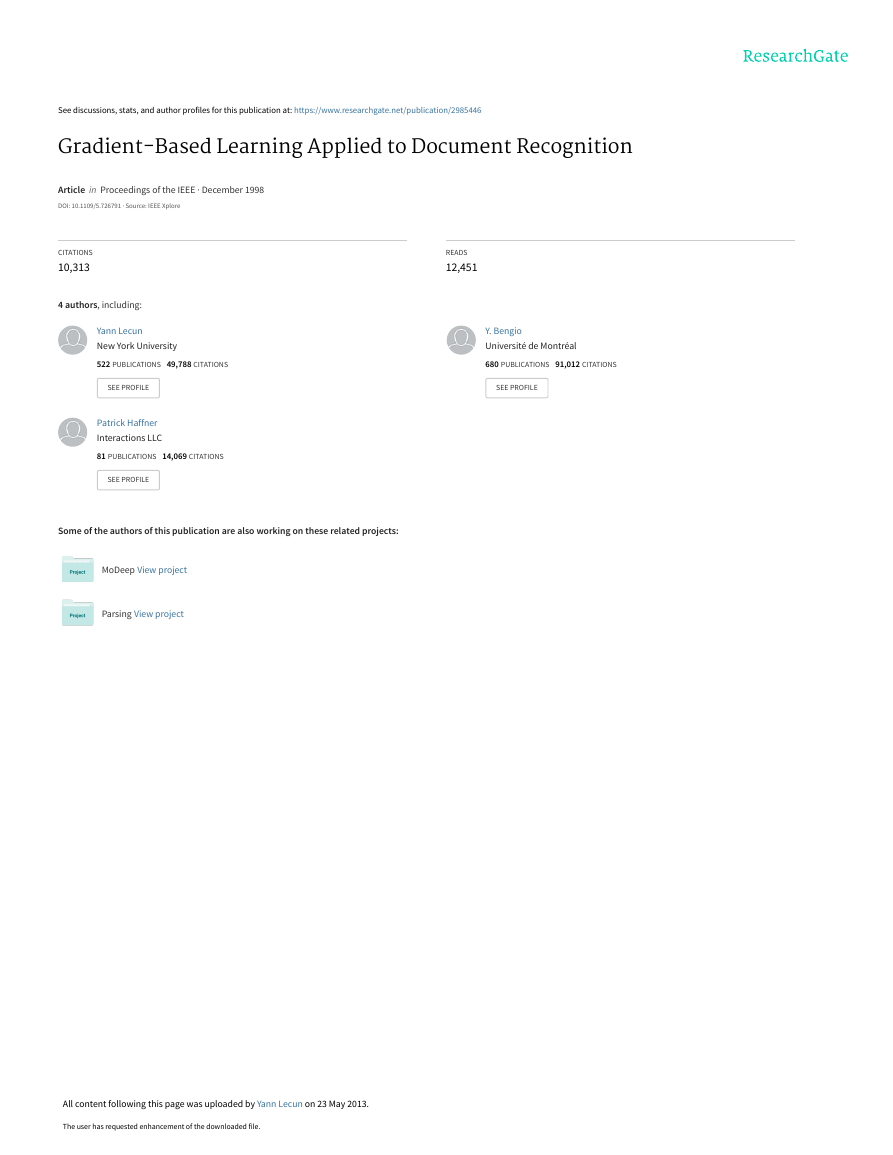

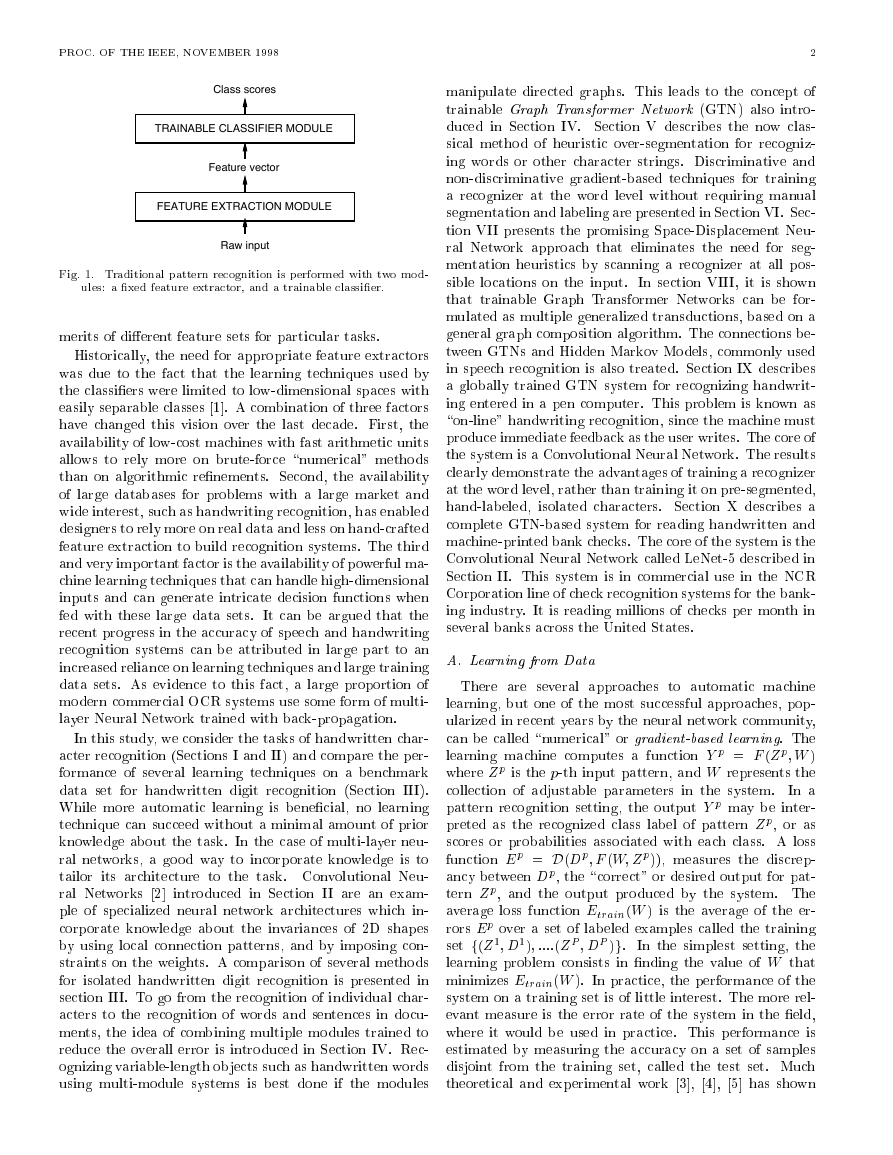
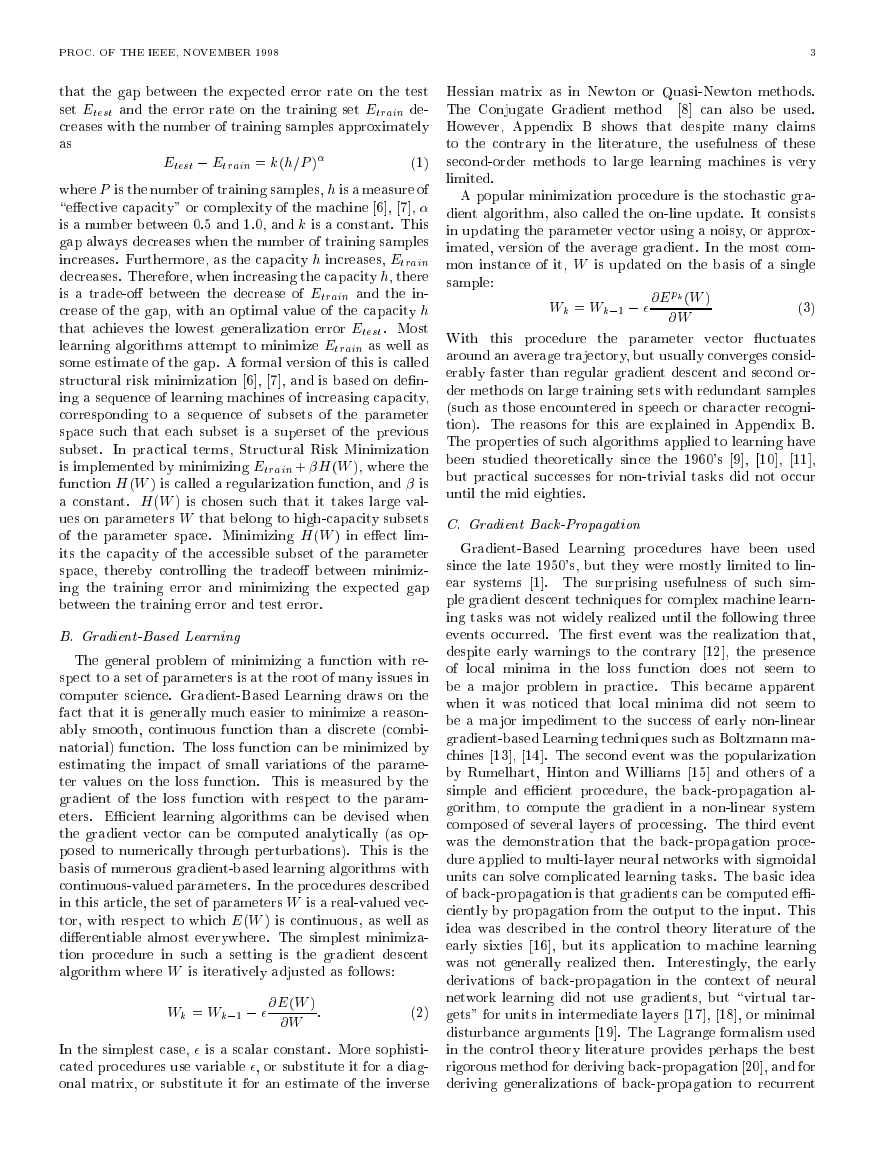

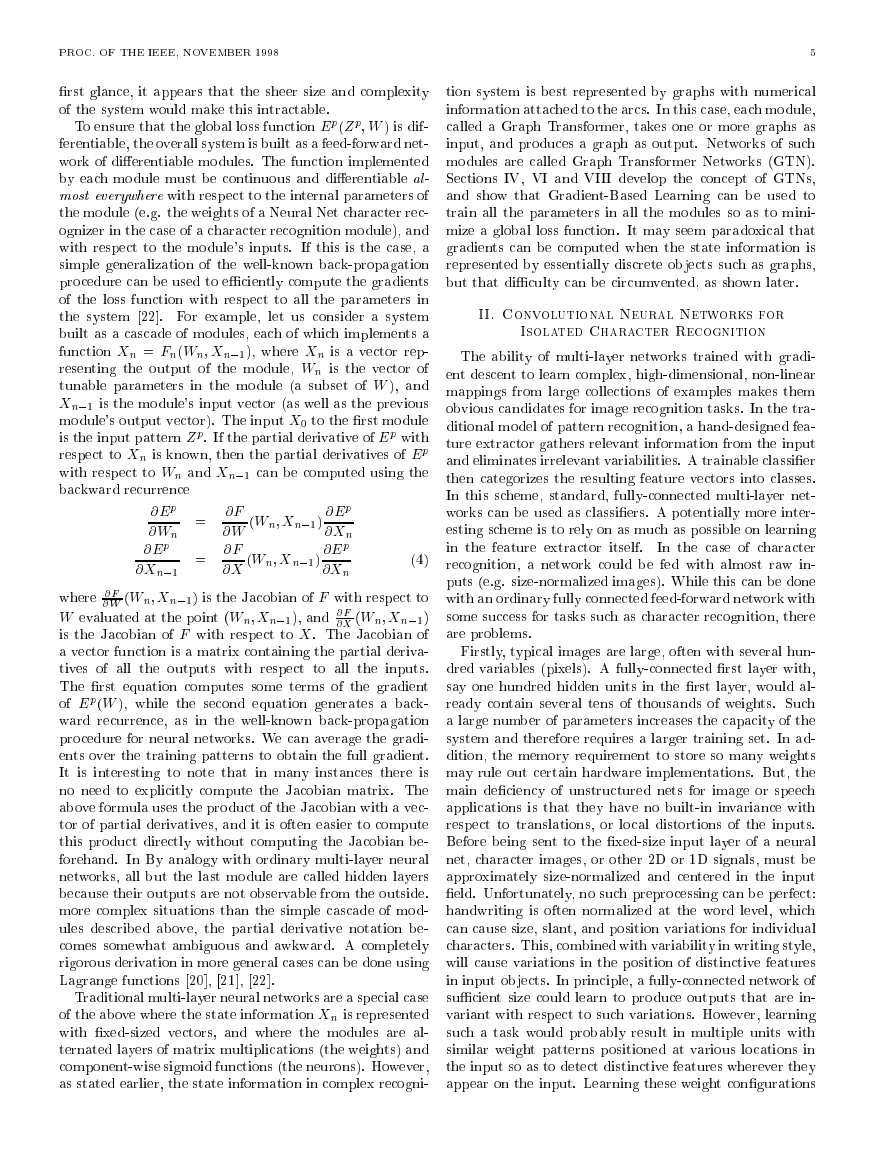
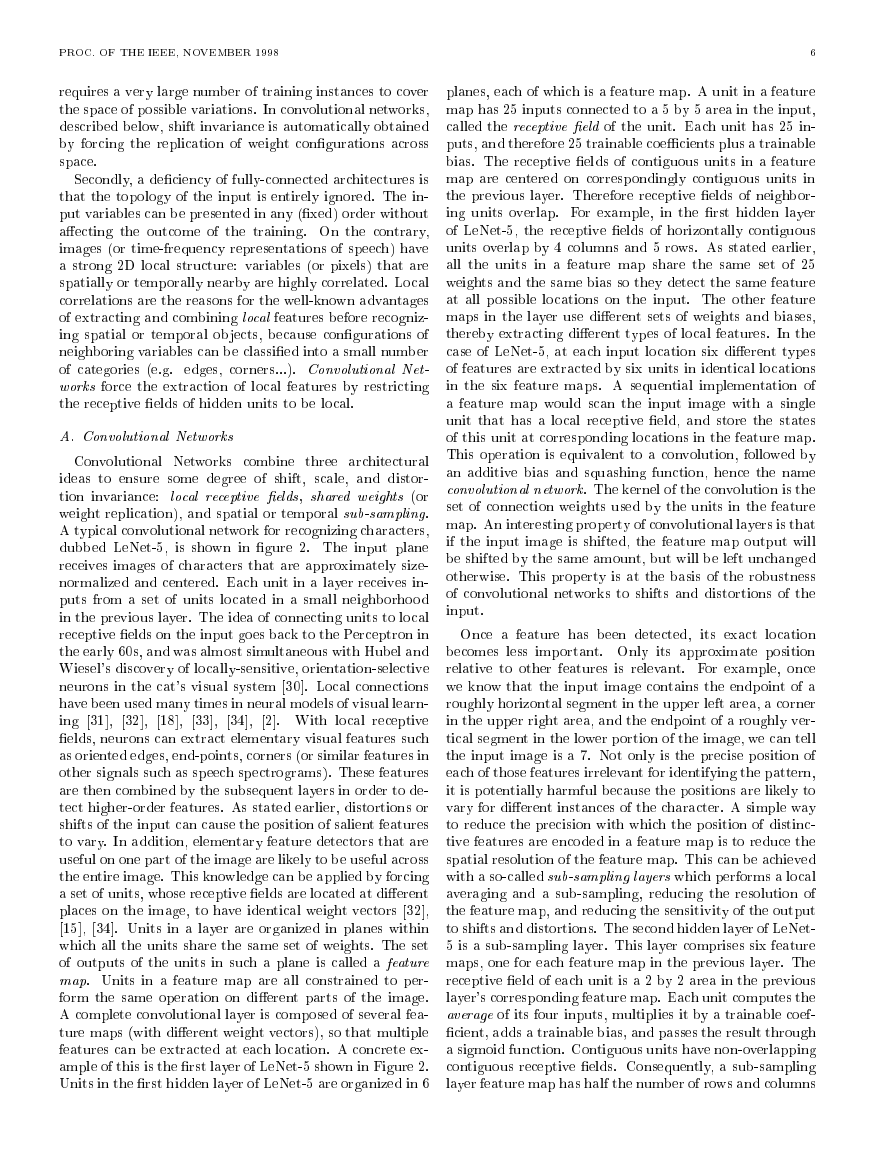
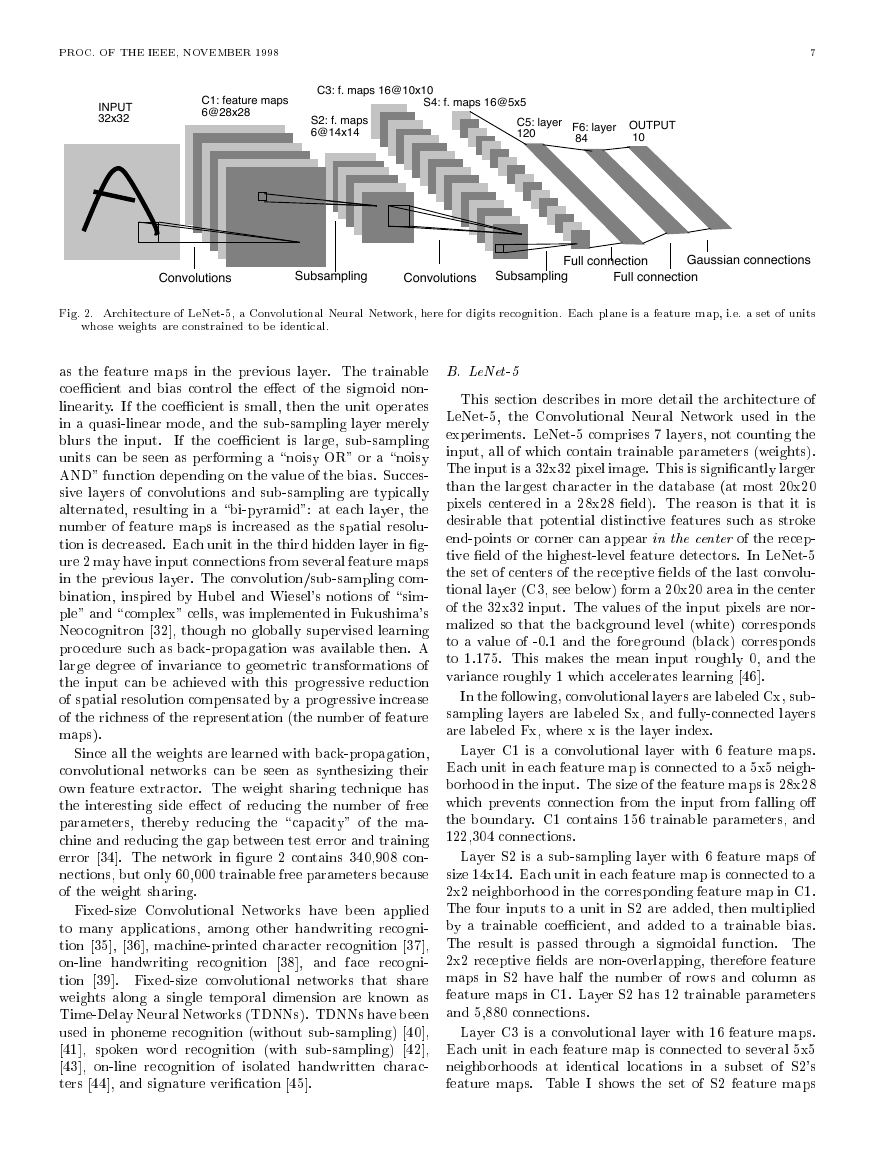








 2023年江西萍乡中考道德与法治真题及答案.doc
2023年江西萍乡中考道德与法治真题及答案.doc 2012年重庆南川中考生物真题及答案.doc
2012年重庆南川中考生物真题及答案.doc 2013年江西师范大学地理学综合及文艺理论基础考研真题.doc
2013年江西师范大学地理学综合及文艺理论基础考研真题.doc 2020年四川甘孜小升初语文真题及答案I卷.doc
2020年四川甘孜小升初语文真题及答案I卷.doc 2020年注册岩土工程师专业基础考试真题及答案.doc
2020年注册岩土工程师专业基础考试真题及答案.doc 2023-2024学年福建省厦门市九年级上学期数学月考试题及答案.doc
2023-2024学年福建省厦门市九年级上学期数学月考试题及答案.doc 2021-2022学年辽宁省沈阳市大东区九年级上学期语文期末试题及答案.doc
2021-2022学年辽宁省沈阳市大东区九年级上学期语文期末试题及答案.doc 2022-2023学年北京东城区初三第一学期物理期末试卷及答案.doc
2022-2023学年北京东城区初三第一学期物理期末试卷及答案.doc 2018上半年江西教师资格初中地理学科知识与教学能力真题及答案.doc
2018上半年江西教师资格初中地理学科知识与教学能力真题及答案.doc 2012年河北国家公务员申论考试真题及答案-省级.doc
2012年河北国家公务员申论考试真题及答案-省级.doc 2020-2021学年江苏省扬州市江都区邵樊片九年级上学期数学第一次质量检测试题及答案.doc
2020-2021学年江苏省扬州市江都区邵樊片九年级上学期数学第一次质量检测试题及答案.doc 2022下半年黑龙江教师资格证中学综合素质真题及答案.doc
2022下半年黑龙江教师资格证中学综合素质真题及答案.doc